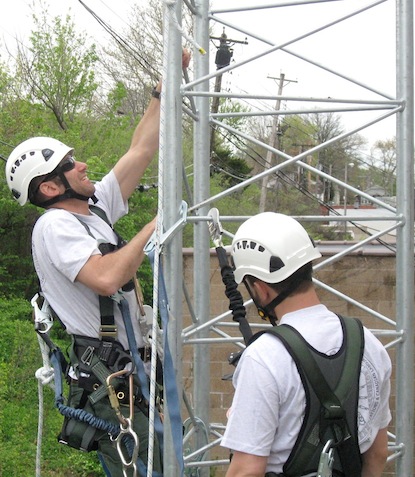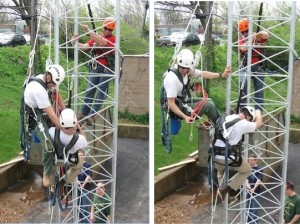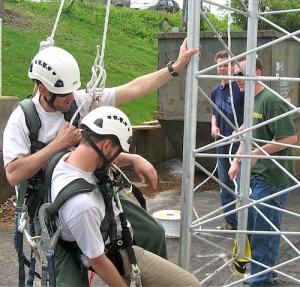Electrical Industry Training Center builds first union training tower in U.S.

By CARL GREEN
Special Correspondent
High on a tower over St. Louis, Jim St. Vrain reaches down and to his right, trying to connect a “biner” (carabineer) to the harness of slumping co-worker Shane McKinney.
St. Vrain makes the connection and then carefully arranges the ropes, connections and cables so he can lower McKinney safely to the ground.
Minutes later, mission accomplished.
In this case, there was no emergency or accident. It was a training exercise to practice rescuing an injured lineman.
Such valuable tower training has been difficult and expensive for St. Louis area workers to acquire, but that has changed with the installation of the nation’s first union-owned training tower at the St. Louis Electrical Industry Training Center on Hampton Avenue.
IBEW Local 1 already has 20 members who have completed the Competent Climber and Tower Rescue certification of CITCA, the Communication Industry Training and Certification Academy. So the local has the skills and training to teach the same program to others, and the first class is now under way.

The industry is expecting an increase in tower work in coming years, and Local 1 plans to be ready. It has a stand-alone cell tower agreement with J.F. Electric and is working on one with PayneCrest Electric.
GROWING DEMAND
John Kahrkoff, director of membership development for Local 1, said AT&T plans to spend $50 million on LTE and tower upgrades in Missouri over the next five years, and J.F. Electric has a contract with Ameren for all of its tower grounding updates.
Also, Ameren’s remote meter reading is performed using the wireless cell towers of the major carriers.
“This is a new market for the IBEW, but a promising one,” Kahrkoff said. “The industry is very dangerous, and many of the tower climbers are underpaid and put into dangerous situations. They are usually low skilled, and the turnover rate is high.
“We hope that by bringing the IBEW safety standards and top training, we can improve the safety record for cell climbers,” he said. “If there is any market that desperately needs to unionize, it is tower climbers. Our journey level members can beat them on safety, quality and skill. We have already proven it.”
AVAILABLE FOR JOURNEYMEN
AND APPRENTICES
The tower program is for apprentices and journeymen who need to learn procedures and practices for work on towers, said Tim Kelley, superintendent of related instruction for the Center.

Installing the 20-foot tower at the Center was the idea of Local 1 Business Manager Frank Jacobs, Kelley said. G.P. Rees Inc. was the contractor.
Workers previously have either learned on-the-job or traveled to a Chicago-area facility for this training at a cost of about $2,600.
The Electrical Industry Training Center is the largest in the Midwest for skilled union electricians and communication technicians, training more than 1,200 apprentices, journeymen and technicians each year.
The Center is managed by the St. Louis Area Electricians Joint Apprenticeship and Training Committee, which is made up of representatives from Local 1 and unionized electrical contractors.


Leave a Reply